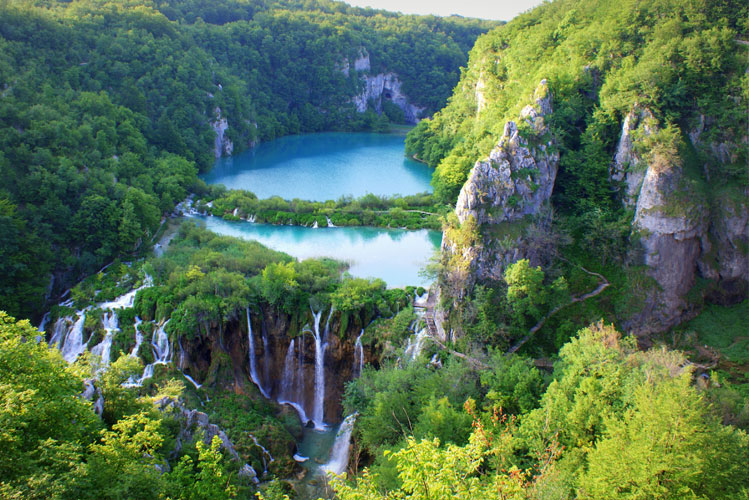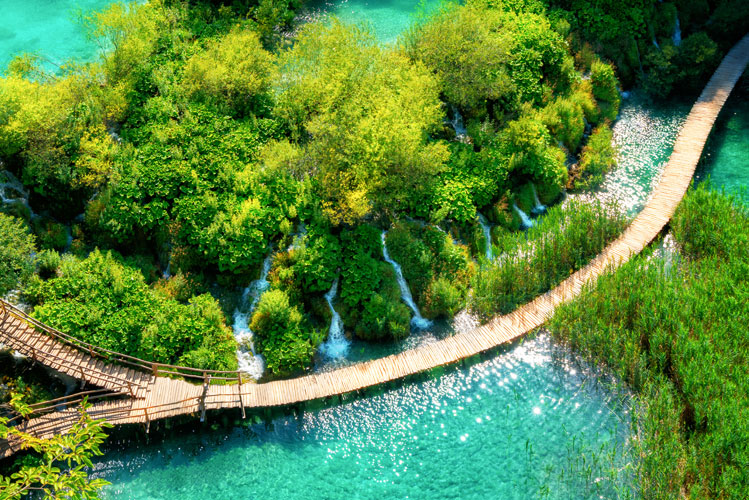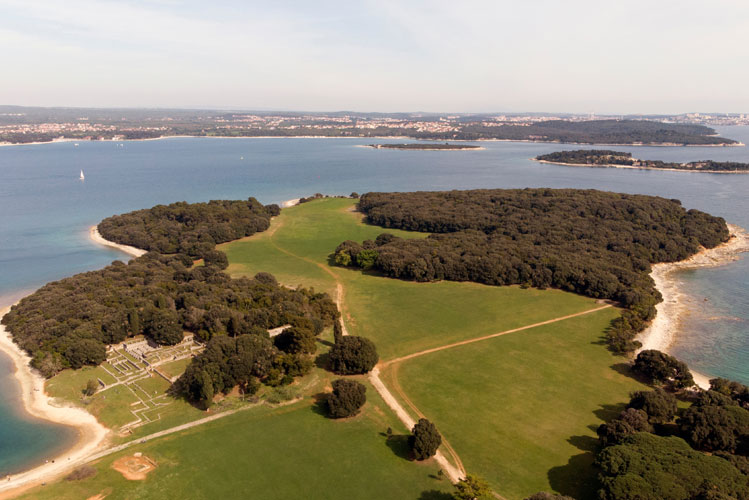Plitvice Lakes – National Park
by Welcome Center Croatia | Last updated Feb 21, 2022 | Published on Feb 21, 2022
Plitvice Lakes National Park covers an area of 19.5 hectares or 48 acres and is situated between Zagreb and Zadar within Lika. The area has sixteen sparkling lakes and lots of waterfalls. It also has bubbling streams. Needless to say, this national park is breathtaking and is great for people who enjoy the sights of nature. In this guide, we will cover everything you should know before you visit Plitvice Lakes National Park.
1. Overview of Plitvice Lakes
Plitvice Lakes National Park is a beautiful place that is full of different species of plants and animals. The forested area is home to lots of birds, mammals, insects, and various plants. Over the centuries, the place developed a great natural ecosystem for different flora and fauna to flourish. You should be able to spot more than 120 species of birds, and this makes it a great place for bird watchers. You may also spot a bear, wolf lynx, or wildcat in the forest, but these are considered harmless. Towards the edges of the forest, you will be able to see deer, badgers, and foxes.
Three rivers supply water to the lakes, and these include Crna, Bijela, and Rjecica. There are also various subterranean sources that supply water to the lakes. In addition, there are various tributaries, springs, and brooks in the park. The waters go over the waterfalls and then go into the Korana river.
As far back as 1893, a commission had already been formed to protect the ecosystem of the park. The community had already realized that the ecology of the park was delicate and quite unique. Although it was already recognized as a great natural environment, it would become a national park in 1928. The government would legalize its status formally in 1949. Decades later in 1979, UNESCO would name the park a World Heritage Site, and this helped to pull tourists to the park. At the time, it was under the former Yugoslavia regime.
A significant part of the park’s history is the Yugoslavia war. At the time, the park was in the middle of the war zone, and rebels seized control of it in March 1992. The rebels would go on to take control of the lakes for four years. Although the occupation was destructive to the park, the natural beauty of the place was still maintained. At the moment, the lakes are some of the most visited places in the entire country.
2. Travertine
Plitvice Lakes has an abnormal topography, and this is because it lays on karst. It is worth noting that this is the case with other national parks in Croatia. Water seeps through the karst or porous limestone and dolomitic rock in the park, and this creates underground streams. In the park, you will see petrified plants that look like stone, and these are referred to as travertine. As the water flows, it picks up minerals from the dolomite beneath the lakes. This helps to create the porous travertine stones. When new travertine is developed, it will sprout moss and other plants, and these will later petrify and create new travertine. The travertine separates the lakes and is constantly being created. More than 75% of the national park is covered with trees, and less than 1% of the space is taken by the lakes and waterfall systems. The rest of the park is covered in pastures, fields, meadows, and settlements.
3. Plants and Animal Life
A key aspect of this park is the flora and fauna. Towards the northeastern section of the park, there are beech forests. Other forms of plant life in the park are fir, spruce, white pine, whitebeam, hornbeam, and flowering ash. The place features about 160 bird species, and these include owls, hawks, cuckoos, starlings, kingfishers, thrushes, wild ducks, and herons. Some bird species visit the park in specific seasons, and these include black storks, ospreys, and butterflies. It is worth noting that the park is home to more than 70 butterfly species.
Some animals you will spot in the park include bears, lynx, and wildcats. You may also spot wolves once in a while. Some animals that are easier to see are rabbits, foxes, badgers, and deer. Some animals have recently made the park their home, and they include pine martens, polecats, stoats, weasels, and martens.
Other rare animals at Plitvice are the Italian crested newt, alpine/ black salamander, and harvest mouse. The population of striped field mice and whiskered bats is still low, but they are quickly growing.
If you appreciate plant life, you will love the varied species in the park. There are about 1400 plant species and sub-species in the park, and these include about 50 species of orchids. Most of these orchids are endemic. Some of the more interesting plants in the park are the Siberian Rayflower and the hawksbeard.
4. Forests and Caves
As noted earlier, the lakes and waterfalls at Plitvice Lakes National Park cover only about 1% of the area. That leaves more than 73,000 acres of varied terrain, and a lot of this is covered by beech, fir, and spruce.
One of the interesting forests in the place is the Corkova Uvala. This is a primaeval forest that features trees that reach a height of 60m. These trees also have a diameter of about 140 cm. This forest is located towards the northeastern section of the park and it hasn’t been touched by human activity. If you enjoy hiking, you should use the well-marked trails to tour the forest.
The park also has a number of caves, and these are quite interesting. One of them is the Supljara Cave, which is located on the eastern edge of the park. You’ll find it near the first entrance, just near Kaluderovac Lake. This cave has three chambers and a 68-metre corridor. The temperature in the cave is always low, and this has made it a great home for scorpions, beetles, and moths.
Before you get to the second Korana waterfall in the eastern section of the park, you will see the Golubnjaca Cave. This one has two entrances with heights of 46 m and 24 m. There is also an antechamber and two cave corridors that run for a length of 65 m.
5. Lakes and Waterfalls
While lakes and waterfalls don’t cover much of the park, they are still essential. In total, the place has 16 lakes, and these are connected. While they interlock, these lakes are still classified into upper and lower lakes.
You will find the distance between the lakes quite long, and the paths are extremely rough. You can choose to move between them using a boat or the electric bus. You should note that the transport costs are included in the admission ticket. Also, remember that the bus and boat will take you through all the lakes. If you choose to walk, you will have to spend about 5 hours.
When you get to entrance 2, you should take the sightseeing train and go to Okrugljak, which is located in the Upper Lakes. Here, there is a lot of untouched plant and animal life, and it is quite breathtaking. There is also a 53m long cave that has two chambers, as well as a pond. Okrugljak Lake covers an area of 4 hectares and has a depth of 15 m. In this place, you will also see the Labudovac Waterfall, which drains its waters in the lake.
When you’re done with this lake, you should walk through the marked hiking trail to Proscansko. This is the highest lake in the park, going to a height of 636 metres. Around it, there is a dense forest, so you can expect to hear the sounds of birds and frogs. In the waters, you should see sprouts and carp. As you follow the hiking trail, you will get to the Ciginovac, and this lake gets its waters from Proscansko. You can then proceed through the trail and go past several small lakes. You can then go down the hiking trail to Galovac Lake, which covers a little over 12 hectares and has a depth of 24 metres. This lake gets its water from three small lakes, and it in turn feeds a number of ponds. A number of waterfalls can be seen around this lake, and one of them even used to have concrete stairs. These stairs have been covered by travertine, and this now forms part of the scenery.



